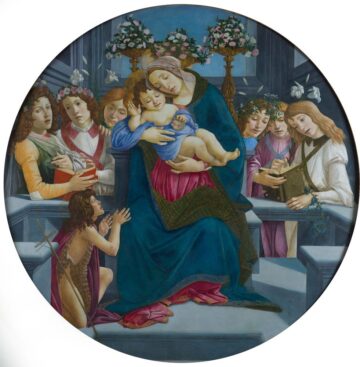
Originally published in the Marina Times San Francisco in November 2023
Alessandro di Mariano di Vanni Filipepi – better known as Sandro Botticelli – is one of the most famous painters of the Renaissance era. He was a part of the aesthetic and technical advancements in 15th-century Florence, and is best known for his iconic painting, Birth of Venus c. 1485. His paintings stood out for their grace and exquisite lines, but the relationship between his drawings and paintings has never been the subject of an exhibit. In Botticelli Drawings, The Fine Arts Museum of San Francisco is unveiling five newly attributed drawings alongside more than 60 works from 39 lending institutions.
Patronage and Portraiture in Florence
As an expert draftsman, Botticelli’s graphic style became a foundational element of his polished, lush imagery. His paintings presented figures rendered in realism and abstraction simultaneously. The human forms float in space draped in flowing gowns that swirl around their bodies, seemingly free from the constraints of gravity. As a sought-out painter of portraits and religious imagery, Botticelli was connected to the great patrons of the Renaissance, the Medici family and Vespucci family. Pope Sixtus IV also hired Botticelli to paint frescos on the walls of the Sistine Chapel. After the political upheavals leading to the Medici’s ouster, Botticelli experienced a decline in popularity but, as Botticelli Drawings shows, his graphic output from that time remains significant.
New Drawings from an Old Master
Botticelli enjoyed mass popularity for his portrait paintings, but his preparatory drawings elevated the line as the primary force behind his figures. Botticelli Drawings features 27 drawings by the artist. The painting The Virgin and Child with the Young Saint John the Baptist (ca. 1468-1480) will be on display with its newly attributed preparatory drawing. Virgin and Child epitomizes the classic Botticelli flow of surface- a dark, flattened backdrop of foliage and trees frames the figures represented in stylized curls of hair and twisting fabric, while John the Baptist’s eyes glance toward us, the viewer. The unprecedented pairings continue with brushed drawings on linen and the resulting painting The Adoration of the Magi (1475-1476), the holy family, this time, placed under a classical temple surrounded by worshippers in vibrant robes.
Botticelli’s Later Years Re-examined
His unconventional stylistic evolution toward linear abstraction and anti-naturalism along with a resistance to perspective took him to a more experimental phase in his later years. Judith with the Head of Holofernes, (ca. 1497-1500) tells the story from the deuterocanonical Book of Judith, and represents the triumph of virtue over evil. Judith’s unnaturally elongated figure emerges from a dark interior shrouded in a crimson veil. She is followed by a ghostlike faceless being while Judith, wielding a sword, regards the severed head of Holofernes. The Devout Jews at Pentecost ca. 1505 is composed in black chalk, pen and brown ink and a wash highlighted with gouache. The artists’ expert draftsmanship informs the hard-lined perspective of the building. The counterpoint to these geometrics are the swooping diagonals of cloth draping the figures in the foreground, many with their backs facing the viewer, which adds to the unorthodoxy of the composition.
“Botticelli Drawings reunites this beloved artist’s graphic output as a whole for the very first time, a challenging endeavor given the rarity and fragility of these works,” noted Furio Rinaldi, curator of prints and drawings at the Fine Arts Museums of San Francisco, “42 public and private institutions have staunchly supported this exhibition with unique loans, contributing drawings from their collections, the majority of which have never before left their lending institutions. This exhibition offers a truly unique opportunity to see and understand Botticelli’s thought and design process leading to the making of his memorable masterpieces.”
Drawing the Line
Concurrent with Botticelli Drawings is an exhibit drawn from the Achenbach Foundation for Graphic Arts- Drawing the Line: From Michelangelo to Asawa. This exhibit consists of rarely-seen works and masterpieces by beloved artists including the treasured work L’Arlesienne (Madame Ginoux) (1888), a large-scale portrait by Paul Gaugin, on view for the first time in more than a decade.